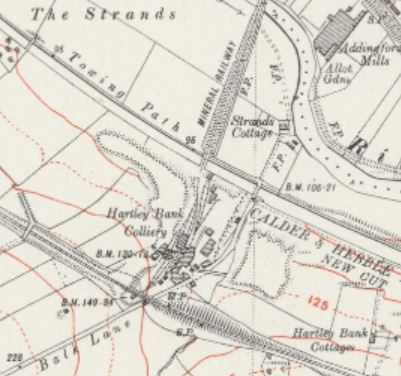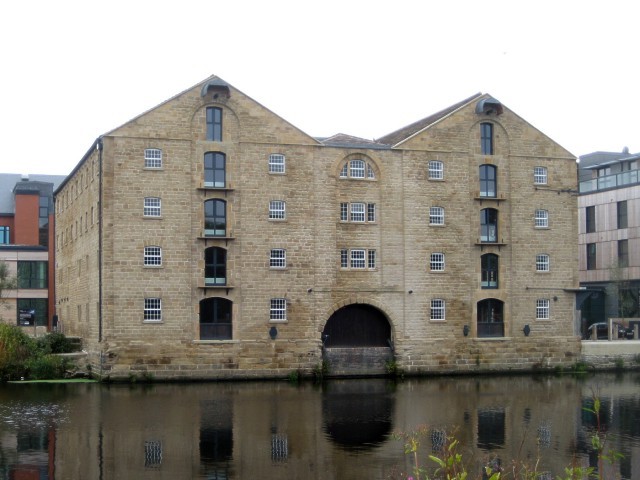

Hartley Bank Colliery[1]
Reproduced with the permission of the National Library of Scotland
Hartley Bank Colliery, near the south bank of the Calder and Hebble Navigation
Constructed between 1758 and 1834, the navigation makes the River Calder navigable between Sowerby Bridge and Wakefield in the West Riding of Yorkshire. in NethertonAncient township of four villages, renamed from Shitlington to Sitlington in 1929., West Yorkshire, was started in 1841 by Messrs Parkinson of Bradford. It was acquired by J & J Charlesworth who sold it to the Flockton Coal Company Ltd in 1872. The colliery became part of the National Coal BoardStatutory corporation created to run the coal mining industry in the United Kingdom under the Coal Industry Nationalisation Act 1946. in 1947 and closed in 1968. The shafts were capped and the shallow coal seams were open-casted before the site was restored for agriculture.
Beginnings
The completion of the Horbury Cut on the Calder and Hebble Navigation and the arrival of the Leeds and Manchester Railway provided impetus for deep mining in Netherton where shallow coals had been got for centuries. Messrs Parkinsons leased coal on the northern edge of Netherton in 1841 and sank two shafts to the Flockton Thin coal, 130 yards (119 m) from the surface. The brick-lined drawing shaft was 11 feet six inches (3.5 m) in diameter and the nine-foot (3 m) upcast ventilation shaft had a furnace at the bottom. Coal production started in 1843, when coal was wound to the surface by horse ginHorse-driven engine used in lead and shallow coal mines., until a winding engine was installed in 1849. It was then transported to the navigation along a short tramway.[2]
Change of owners
By 1872 the colliery was owned by J & J Charlesworth, who sold it to the Flockton Coal Company. The company leased the mineral rights from several local landowners and began significant developments, including shaft deepening to the Old Hards seam, from which excellent house coal was produced; Buckingham Palace was a customer during the reign of Queen Victoria. A third shaft, 12 feet (3.7 m) in diameter, was sunk to the New Hards seam at 198 yards (181 m), and the other shafts were deepened in the late 1870s. The ventilation furnace was replaced by a Guibal fan at the top of the new shaft, and four Lancashire boilers provided power.[2]
Richard Sutcliffe was a manager in the pit during the 1880s and 1890s. He developed coal-cutting machinery and pioneered underground conveyor belts, which were subsequently made at Sutcliffe’s Universal Works in Horbury.[3] By 1895 the pit had 170 underground workers and 33 on the surface.[2]
Twentieth century
In 1901 the management decided to mine the shallower seams that had been worked before the pit was sunk by small concerns, but water ingress made progress slow and the scheme was abandoned as unworkable in 1903. In 1913 the colliery was short of workers after a large number of men enlisted into the army at the outbreak of the First World War. The pit was not only short of manpower, outdated plant made the problem worse, but its coal was still in high demand. Benjamin Elliott and his sons joined the company in 1914 and were able to change the colliery’s fortunes.[4]
The company deepened the No. 2 shaft to access Wheatley Lime coal at 230 yards (210 m), connected the ventilation to No. 3 shaft and started producing coal using the longwall system in 1917. In 1920 a screening plant was installed. The colliery employed 600 men in 1923, 520 of them underground and electric coal cutters were introduced the following year. Underground conveyor belts were introduced in 1927.[4]
The colliery employed more than 600 men in the 1930s getting coal from the Flockton Thin, Wheatley Lime and had proved the presence of the Blocking seam. Pit head baths were built in 1933 but were not fit for purpose, and new ones opened in 1938. More than half the pit’s output was sold within ten miles (16.1 km) of the colliery, and about a third was sold to public utilities.[5]
The Elliotts bought all the colliery shares in 1940 and set about modernising the colliery, completely electrifying it using power from the Elliott Colliery Company. The Beeston seam was proved in 1944. The wooden heapstead and old wooden head stocks were replaced with concrete and steel structures in 1946.[5]
Nationalisation
On 1 January 1947 the colliery became part of the National Coal Board’s Barnsley Area. It employed 560 men, 460 of them underground working the Flockton Thin, New Hards and Wheatley Lime seams. Output was 250,000 tons per annum and the pit had an expected life of at least 40 years. The NCB set about developing the Beeston seam and by 1951 the colliery was completely modernised.[5] In 1960 the pit had 600 employees.[6] By 1967 the Beeston seam was proving difficult to work, and Hartley Bank closed the following year with a loss of 478 jobs. Many men transferred to other pits in the Barnsley Area. After salvage the surface plant was demolished and the shafts were capped. Shallow unworked coal was opencasted and the site was returned to agricultural use. The unworked Beeston seam was mined by Denby Grange Colliery after 1989.[7]
Transport
The company had a coal staithe on the Calder and Hebble Navigation where coal was loaded into barges and built a short mineral line that crossed the navigation and the River Calder to sidings by the mainline at Horbury where it also had a landsale depot. Before Nationalisation about 40% of coal was transported by rail, 20% on the navigation and the rest by road via Balk Lane.[7]
By 1963 miners had to travel underground by paddy train for a mile to their place of work. 34 % of the coal was moved by canal, mostly to power stations, and 42% was moved by rail. Industry used 41% of the pit’s output, power stations used 42%, 12% was coking coal and 5% was for domestic use.[7]
Incidents
On 23 May 1924, when coal was being undercut from a face in the Old Hards seam, an outburst of methane was ignited by a spark from the electric cutter. Four men were asphyxiated by the afterdampDamps is a collective name given to all gases other than air found in coal mines in Great Britain. The chief pollutants are carbon dioxide and methane, known as blackdamp and firedamp respectively. , and two were injured.[4]
In 1960 James Gillan, the pit manager, was awarded the George Medal for the rescue of an undermanager who had been overcome by firedampDamps is a collective name given to all gases other than air found in coal mines in Great Britain. The chief pollutants are carbon dioxide and methane, known as blackdamp and firedamp respectively. .[6]
